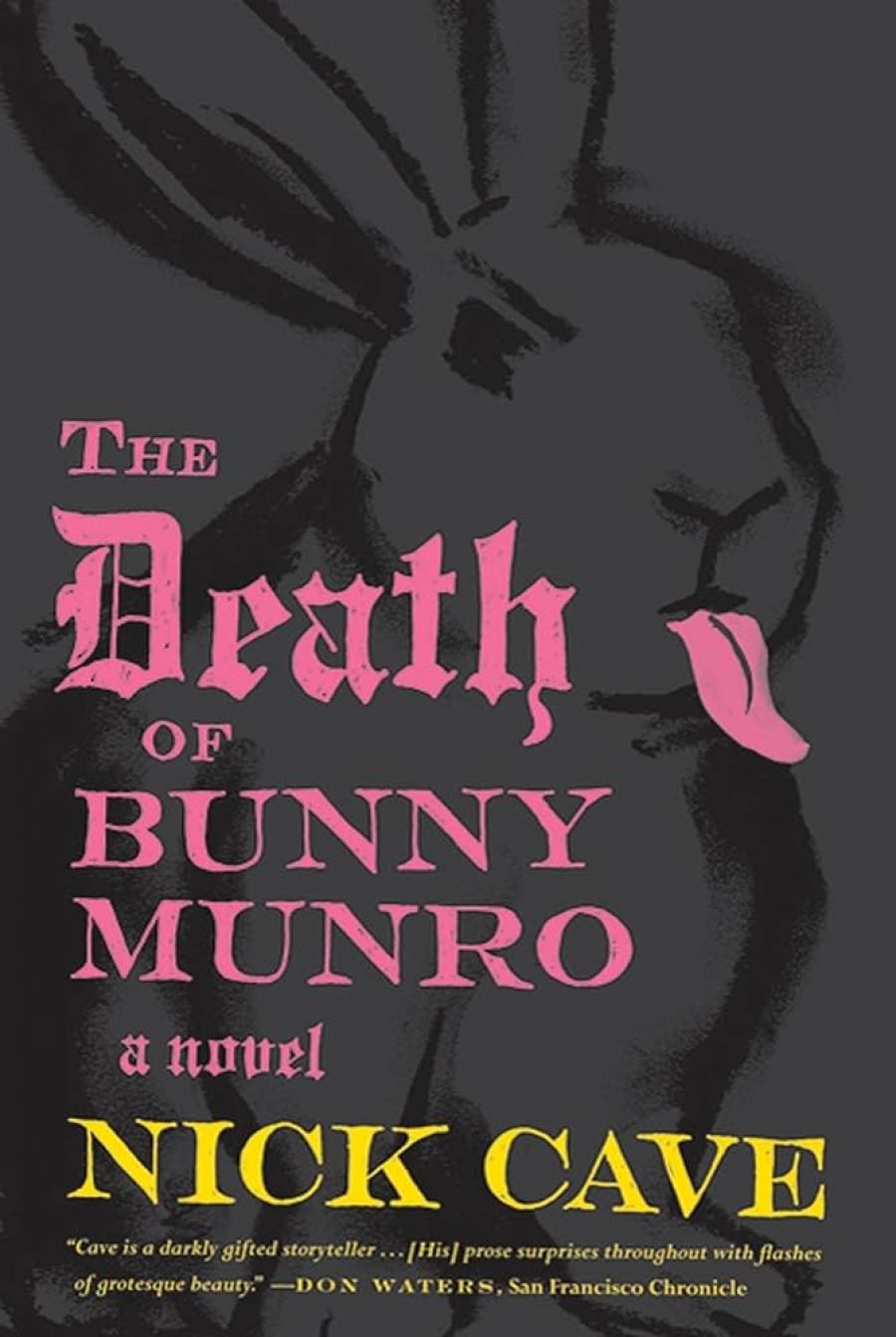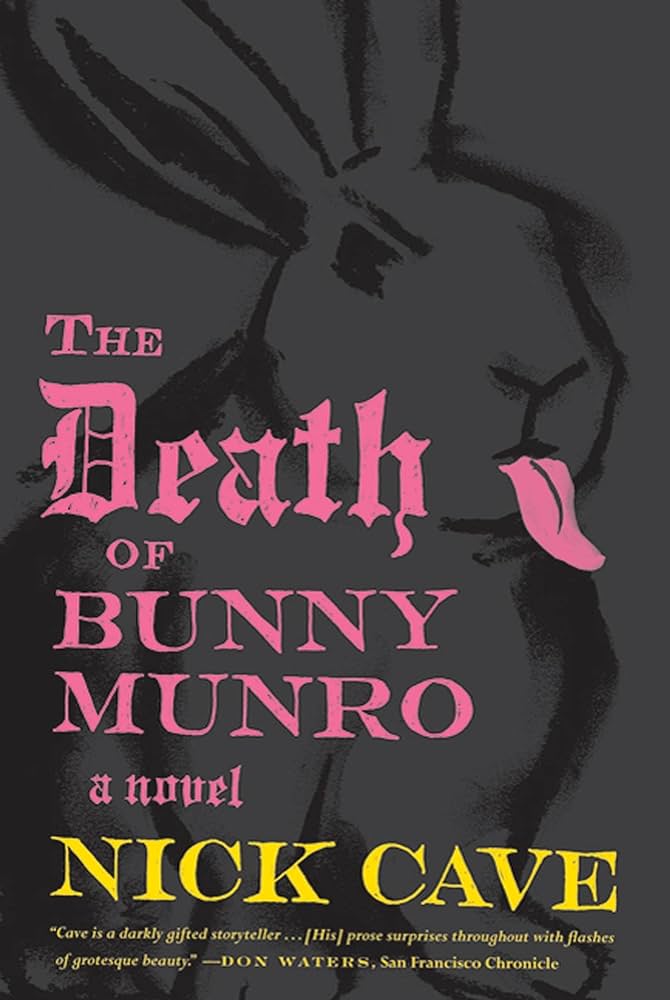
- Free Article: No
- Contents Category: Fiction
- Review Article: Yes
- Article Title: ‘One day, Bunny Boy’
- Online Only: No
- Custom Highlight Text:
Although Nick Cave’s second novel makes strong claim to the musician’s skills as a writer, in the end it is too morally opaque to succeed as a work of sustained fiction. There is an overwhelming didacticism to The Death of Bunny Munro that delights too much in its own surety to be persuasive, and leads to a disappointing suspicion that, despite Cave’s renown as a populist intellectual, there is little in the book to consider besides the sexual conscience of its titular protagonist. Bunny Munro is certainly entertaining, and his exploits memorable, if puerile, but the final authorial judgement of the character is predictable, and, worse, leaves little room for readers’ thoughts. Exactly what Munro’s version of family life undone by libidinous desire contributes – even when told with remarkable lyricism – remains moot in the novel.
- Book 1 Title: The Death of Bunny Munro
- Book 1 Biblio: Text Publishing, $32.95 pb, 288 pp
- Book 1 Cover Small (400 x 600):

- Book 1 Cover (800 x 1200):

Like many of Cave’s best-known songs, The Death of Bunny Munro’s narrative turns for the most part on biblical tropes of moral sin and suffering, atonement and redemption and the triad of symbolic characters: Father, Son and Holy Ghost. Barry is a thinly disguised Christ – updated for our times with a pornographic imagination, alcohol and nicotine dependency, and a job as a travelling salesman – and Cave intends us to understand him as an exaggerated, suffering Everyman. The twist is that Munro doesn’t heal on his way to the afterlife, mindlessly boozing and screwing his way to the grave, indifferent to suffering. Cave’s apparent intention is to create a new Christ to whom we can relate more than the bloodless, serene Saviour of the Church. Instead, he creates a tragicomic figure, forgiven his infantile behaviour on account of his preternatural ‘appetites’.
The arc of Munro’s narrative is split into three parts: ‘Cocksman’, ‘Salesman’ and ‘Deadman’. In the aftermath of Bunny’s wife Libby’s suicide as a result of his terminal neglect of both her and their nine-year-old son, Bunny Jr, father and son set out on a working road trip to expunge their unacknowledged grief. Bunny’s emotional ineptitude is explicit from the outset – after masturbating at his wife’s funeral, he has sex with a friend’s girlfriend at the wake – and his immediate plan is to seduce housewife after housewife throughout southern England, continuing on the pretext of selling beauty products as an employee of Eternity Enterprises. Surely as he is morally reprehensible, however, Bunny’s virility begins to subside as he becomes aware of his own guilt, which becomes apparent in thwarted sexual opportunities and various supernatural occurrences.
The humour in Bunny’s situation is directly proportionate to his ignorance of his own damnation. Cave plays this card on every page until Munro’s predestined fall. Everyone despises Bunny, yet he is impervious, enthralled by his own powers of sexual magnetism. By shredding Bunny’s clothes and destroying his favourite belongings before her death, Libby couldn’t have sent him a more direct message of his implication in her suicide, yet Bunny misses the point on discovering their house in disarray:
Bunny looks around him and is pole-axed ... An unspecified guilt, from out there on the boundaries of his psyche, pops its head over the fence, then ducks back down again. But this uneasiness is superseded by a second, more urgent, mood-altering realisation – that sex with his wife is almost certainly off the agenda and Bunny feels super pissed-off.
Moreover, on discovering Libby dead in the nightdress she wore on their honeymoon, her purpled face and buckled body hanging from the security grille in their bedroom, Bunny admires her ‘tits’. Later, reflecting on the incident, he muses, ‘What had got into her? She must have been crazy.’
The limited realm of Munro’s senses is the main subject of ‘Salesman’, with Cave reiterating our anti-hero’s haplessness in successive, disastrous visits to caricatured client after client. All the while, Bunny Jr is left to wait in the car, where he pours over an encyclopedia given to him by his mother. The child’s character and grief are drawn as one-dimensionally as the father’s – but in apposite terms of innocence – with the implication that sexual desire is the definition of adulthood. During Bunny’s visit to ‘loyal customer’ Mylene Huq of Rottingdean – ‘She just loved that body cream!’ – Bunny Jr meets her daughter. The girl says, ‘You dad is giving my mum a fuck’, but Bunny Jr doesn’t understand. Later, he tells his father about the girl and suggests that he should go back and do the same to her. Bunny replies, ‘One day, Bunny Boy, one day!’, a rare moment of intimacy between the two.
The spectre of death pursues Bunny in the forms of his sick and ageing father and the shadowy figure of the Horned Killer, a sex murderer on the loose and making his way towards Bunny’s hometown of Brighton. Both figures represent endpoints of Bunny’s trajectory: Bunny’s father being a hateful, lonely man who is dying alone, and the Horned Killer a criminal who will inevitably be caught and forced to atone for his sexual malevolence. Cave’s handling of both is stagy, but the parallel symbolism involved is one of the more interesting elements of the novel. In a book populated by thinly drawn omens – thunderclaps, rain, apparitions, mad starlings, burning piers, ‘insulted skies’, wasps’ nests – these two figures are genuinely effective, and when Bunny finally intersects with them, the death knell is chilling.
‘Deadman’, the final part, reads more like the Nick Cave of his first novel, And the Ass Saw The Angel (1989) and earlier, horror-fascinated music created with The Bad Seeds. Cave excels at grotesquerie, and Munro’s last encounter with a drug-worn woman, the circumstances of his death and its purgatorial aftermath are drenched in nauseating, corporeal descriptions. One short, extraordinary passage rivals Ira Levin’s memorable evocation of demonic copulation in Rosemary’s Baby (1967) as the most disturbing of its kind. Cave’s novel would have been better served by more of this taut, hallucinatory writing, and less of its wealth of potty one-liners and obsessive gynaecological imaginings. As it is, there is not enough depth to Munro for his baptism of the soul to convince.


Comments powered by CComment